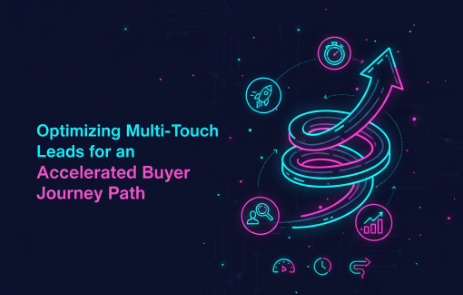In a competitive B2B environment, simply implementing multi-touch lead strategies is no longer enough. To drive meaningful results, marketers must continuously refine and optimize their campaigns. Optimization ensures that every engagement adds measurable value, enhances lead quality, and accelerates the path to conversion. The true objective lies in Maximizing the Buyer Journey, ensuring that each touchpoint contributes strategically to buyer progress. Through optimization, businesses can shorten sales cycles, improve targeting precision, and deliver consistent brand experiences that influence decisions.
Understanding the Dynamics of an Accelerated Buyer Journey
An accelerated buyer journey does not mean rushing prospects through the funnel. Instead, it involves removing friction, providing clarity, and aligning content with buyer intent at each stage. Modern buyers expect seamless interactions and personalized experiences. By optimizing multi-touch campaigns, marketers can anticipate buyer needs and deliver the right content through the right channel at the right time. This dynamic approach helps maintain engagement while moving leads efficiently toward conversion.
Why Multi-Touch Leads Enhance Conversion Rates
Conversions are not triggered by one event but by a series of meaningful interactions. Each touchpoint plays a psychological role in reinforcing the buyer’s decision-making confidence. By designing multiple layers of engagement, marketers ensure that leads remain actively connected with the brand throughout their journey. This ongoing engagement increases familiarity, mitigates objections, and nurtures leads until they are ready to convert. The outcome is a higher conversion rate and stronger pipeline velocity.
Identifying High-Impact Buyer Touchpoints
To enhance conversions, it is critical to identify which touchpoints have the greatest influence on buyer behavior. This includes email campaigns, display ads, social media engagement, whitepapers, webinars, and product demos. Multi-touch strategies ensure that these channels are not treated independently but work together in a synergistic flow. When aligned effectively, these touchpoints create a unified narrative that reinforces the buyer’s need for a solution and positions the brand as the optimal choice.
Mapping Touchpoints for Strategic Optimization
To optimize multi-touch leads effectively, marketers must first map all critical touchpoints across the buyer journey. This mapping process identifies where prospects interact most frequently, what triggers engagement, and where drop-offs occur. Once identified, marketers can refine these touchpoints to enhance user experience. For instance, improving website navigation, optimizing email subject lines, and refining ad targeting all contribute to better lead retention and movement through the funnel.
Using Data and Analytics to Refine Performance
Data-driven decision-making forms the core of multi-touch optimization. Analytics reveal which touchpoints are performing well and which require adjustment. Metrics such as click-through rates, engagement duration, and conversion paths provide actionable insights. By analyzing data from CRM systems, marketing automation platforms, and attribution models, marketers can determine which combinations of channels deliver the strongest results. Continuous analysis and optimization ensure that marketing efforts remain effective, relevant, and profitable.
The Role of Intent Data in Journey Acceleration
Intent data is an invaluable tool for identifying when a lead is most likely to engage or convert. By tracking behavior such as content consumption, search patterns, and engagement timing, intent data allows marketers to predict buyer readiness. Incorporating this insight into multi-touch campaigns helps deliver personalized interactions at optimal moments. The result is an accelerated buyer journey where leads receive tailored engagement based on their current intent and stage of research.
Streamlining Multi-Channel Experiences
An optimized multi-touch strategy ensures that buyers experience seamless transitions across different channels. Consistent messaging and cohesive branding across email, display, social, and content syndication channels create a unified journey. When every touchpoint reinforces the same message, it strengthens brand recall and trust. This harmony between platforms minimizes confusion, keeps leads engaged longer, and promotes a more natural progression toward purchase decisions.
Leveraging Automation for Efficiency and Scale
Optimization also involves automating repetitive tasks to maintain consistent engagement. Marketing automation platforms can manage workflows, score leads, and trigger personalized communications based on real-time behavior. Automation ensures that no opportunity is missed, even as campaign volumes increase. It also allows teams to focus on strategy and creativity rather than manual follow-ups. Through automation, multi-touch marketing becomes scalable, efficient, and adaptable to evolving buyer expectations.
Enhancing Collaboration Between Marketing and Sales
Optimizing the buyer journey requires strong alignment between marketing and sales teams. Shared data, transparent communication, and unified performance metrics ensure that both teams are working toward common objectives. Multi-touch campaigns provide sales teams with valuable engagement insights that enable more meaningful follow-ups. This collaboration accelerates lead qualification and improves conversion rates, creating a smoother handoff from marketing to sales.
Measuring the Impact of Optimization Efforts
Optimization is a continuous process that depends on regular measurement. Multi-touch attribution models allow marketers to assign value to each engagement and identify which touchpoints have the most influence on conversion. Tracking these metrics provides a deeper understanding of campaign effectiveness and ROI. Over time, these insights can guide budget allocation, content development, and targeting strategies. Measuring and refining each step ensures that optimization remains aligned with business goals.
Future Trends in Multi-Touch Optimization
As artificial intelligence and predictive analytics continue to evolve, optimization will become even more sophisticated. Future campaigns will rely on AI-driven algorithms that predict engagement patterns, personalize touchpoints in real time, and dynamically adjust messaging. This innovation will allow brands to deliver precisely what buyers need at every stage. Companies that invest in optimization today will remain agile and competitive, ensuring long-term success through continuously improved buyer journeys.
About Us:
Acceligize is a global B2B demand-generation and technology marketing firm specializing in performance-driven lead generation solutions. Their services include content syndication, account-based marketing, intent and install-based targeting, and custom campaign strategies. Leveraging data science, technology, and human intelligence, Acceligize helps clients reach high-quality audiences and drive conversions across the full marketing funnel.

